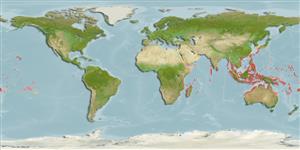Classification / Names
Common names from other countries
Main reference
Size / Weight / Age
Max length : 60.0 cm TL male/unsexed; (Ref. 9710); common length : 40.0 cm TL male/unsexed; (Ref. 5450); max. published weight: 8.0 kg (Ref. 37816)
Environment
Marine; freshwater; brackish; reef-associated; catadromous (Ref. 46888); depth range 0 - 3 m (Ref. 86942)
Climate / Range
Tropical, preferred 28°C (Ref. 107945); 35°N - 32°S, 28°E - 135°W
Distribution
Indo-Pacific: Red Sea south to Transkei, South Africa (Ref. 4393) and east to the Hawaiian and Marquesan islands, north to southern Japan, south to New Caledonia and Norfolk Island (Ref. 8879) and Tuamotu Islands (Ref. 90102).
Countries | FAO areas | Ecosystems | Occurrences | Introductions
Short description
Dorsal
spines
(total): 4 - 5;
Dorsal
soft rays
(total): 8-9;
Anal
spines: 3;
Anal
soft rays: 8 - 10. Bluish brown or green dorsally; flanks and abdomen silvery; dusky spots on upper row of scales, giving indistinct longitudinal stripes (Ref. 9812). Dorsal and upper lobe of caudal fin with dark-blue tip. Anal, pelvic, and pectoral fins yellow. Pectorals also with dark blue spot dorsally at origin (Ref. 9812). Pectoral-fin axil scale very long.
IUCN Red List Status (Ref. 115185)
Threat to humans
Harmless
Human uses
Fisheries: commercial
More information
ReferencesAquacultureAquaculture profileStrainsGeneticsAllele frequenciesHeritabilityDiseasesProcessingMass conversion
Tools
Special reports
Download XML
Internet sources
Estimates of some properties based on models
Phylogenetic diversity index
PD50 = 0.5312 many relatives (e.g. carps) 0.5 - 2.0 few relatives (e.g. lungfishes)
Trophic Level
2.3 ±0.14 se; Based on food items.
Resilience
Medium, minimum population doubling time 1.4 - 4.4 years (K=0.23-0.28)
Vulnerability
Moderate vulnerability (40 of 100)
Price category
